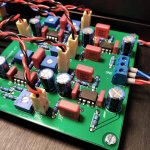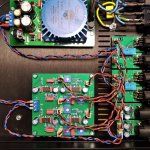Hello everyone,
I have found this paper by TI http://www.tij.co.jp/jp/lit/an/slyt299/slyt299.pdf and designed an active crossover in this way.
It gives a linear phase response and avoids coupling capacitors. I prefer DC coupled designs and avoid coupling capacitors whenever I can. For compensating the low frequency loss in open baffle or dipole speakers I have added a low freq. boost. It can also be useful with closed subwoofers.
I use 2 of these crossovers in my active speakers one for dipole bass F.A.S.T and the other one in my studio monitors and I'm very pleased by the results.
I have found this paper by TI http://www.tij.co.jp/jp/lit/an/slyt299/slyt299.pdf and designed an active crossover in this way.
It gives a linear phase response and avoids coupling capacitors. I prefer DC coupled designs and avoid coupling capacitors whenever I can. For compensating the low frequency loss in open baffle or dipole speakers I have added a low freq. boost. It can also be useful with closed subwoofers.
I use 2 of these crossovers in my active speakers one for dipole bass F.A.S.T and the other one in my studio monitors and I'm very pleased by the results.
Attachments
Odd that that article never mentions state variable filters, despite appearing to be closely related.

